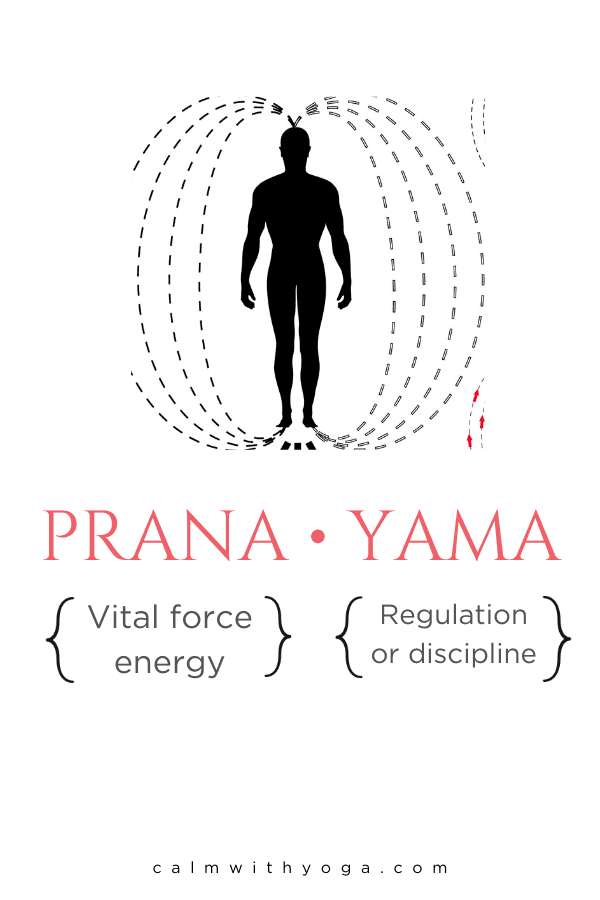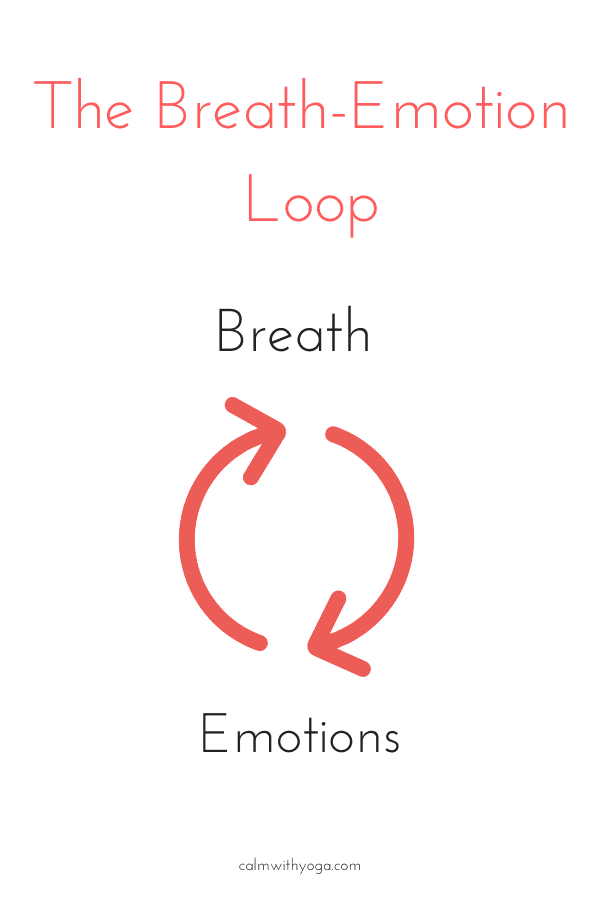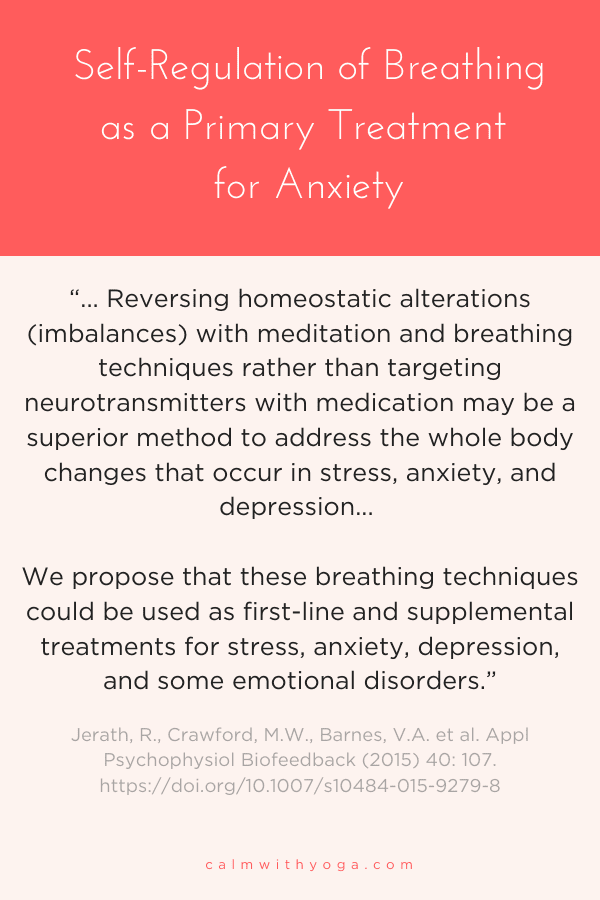– Sutra 1.34, Book 1, The Yoga Sutras of Patanjali, authoritative ancient text on the 8-Limbed Yogic Path Just when you think you have a handle on things, something happens to trigger yet another layer you were unaware of. Trying to control a mind on overdrive and overpowering emotions is exhausting. I’m no stranger to this space since I’ve been battling anxiety since childhood. For the most part (on good days) I’ve got it (somewhat) under control although it’s constant work to manage it. The truth is that tending to your mental health and well-being is a daily life practice. If you’re consistent with it your quality of life can improve over time and anxiety will feel much more manageable…
Pranayama Practice: The Ancient Drug-Free Solution
One way to achieve this is to adopt a regular yoga practice. I’m not just talking about the asanas (yoga postures) although those are for sure helpful… I’m talking about the practice of pranayama (yoga breathing.) It’s not always easy to make it to the studio for a class or stick to a home practice, but it may be easier to commit to a regular practice of a few minutes of deep breathing as a form of yoga practice… Breathing exercises are easy to do on the go as most of the time no one can even tell you’re doing them. Ancient yogis believed in the calming and grounding power of the breath so much they dedicated an entire limb or section to it called pranayama, which is Sanskrit for ‘life force regulation through breath control.‘ The Hatha Yoga Pradipika, a 500-year-old ancient text on Hatha Yoga (mainly focused on yoga poses) states that: Pranayama exercises typically consist of three phases: the Lord of the mind is the breath; the master of the breath is the nervous system; quietness of the nerves and concentration depend solely on the steady, smooth, and rhythmic sound of the inhalation and exhalation. 1- exhaling 2- inhaling 3- breath retention (kumbhaka)
Breath is intimately tied to our emotional and mental state creating the Breath-Emotion Loop:
1- Our emotions and thoughts influence our breathing rhythm.
Next time you’re overtaken by anxiety try and notice your breathing pattern. It’ll likely be short and fast. And vice versa if you’re in deep concentration or engaged in a pleasant conversation you’ll likely notice your breath is slower, longer, and maybe even deeper.
2- Our breathing rhythm can influence our mental/emotional state.
If you were to start breathing rapidly taking short and shallow breaths you’ll likely start feeling either awake and alert, or anxious and on guard. And so, if you begin breathing slowly and deeply you will most probably begin to feel less uneasy and calmer. This Loop functions very quickly. In just a few minutes you can begin to regain control of your mental/emotional state by consciously controlling your breath. This is because deep controlled breathing actually sends signals to your body and brain that activate parts of your calming, relaxing, and soothing nervous system while deactivating your stress response. Science seems to back this ancient yogic wisdom up, as numerous studies are indicating that a regular, consistent yogic breathwork practice can be efficient and useful in the treatment of anxiety disorders and chronic stress, perhaps even more so than medication alone: (1)
3 Pranayama techniques to help you create more inner calm:
#1 – Nadi Shodhana (alternate nostril breathing):
This technique involves the alternating use of the right and left nostrils as a means of balancing not just your mood but also your two brain hemispheres! This is the same technique that Hillary Clinton used to help her cope with stress on the campaign trail. As she told Anderson Cooper in a CNN interview: “I can only say based on my personal experience if you’re sitting cross-legged on the yoga mat and you’re doing it and you’re really trying to inhale and hold it and then have a long exhale it is very relaxing.”
#2 – Ujjayi (Warrior breath, ocean breath, victorious breath):
Ujjayi is a super simple technique that involves gently constricting the back of your throat so your inhales and exhales sound like ocean waves ebbing and flowing. This is the same breath used in traditional Ashtanga classes.
#3 – Calming Breath:
Just 5 minutes a day of the following breathing technique can help you increase inner calm, mental focus, and vital energy. You’ll notice that the exhale is much longer than the inhale. It’s been shown that longer exhales help to activate your parasympathetic nervous system. This is the branch of your nervous system that oversees the relaxation and regeneration response (and therefore helps to relieve anxiety!) (2) HOW TO: Practice this daily, and when you become familiar and comfortable with this practice then go on to add another 5-minute session each day too. Ideally, you want to aim at a 5-minute session every morning before starting your day and a 5-minute session every evening as you wrap up your day. Again, pranayama for anxiety isn’t a magic pill – the effects are cumulative, not immediate (most of the time.) Sure, you can start to feel more relaxed in a few minutes of practice in the moment but keep in mind that to reap the FULL benefits you’ll want to practice this daily. Make it a habit and incorporate it into your daily like and soon your relationship with anxiety will shift. REFERENCES : (1)https://www.ncbi.nlm.nih.gov/pubmed/25869930 (2)https://www.sciencedirect.com/science/article/pii/S0306987706001666



title: “Relieve Anxiety With Pranayama Yogic Breathing Motherhood Community” ShowToc: true date: “2022-11-29” author: “Ila Gonzalez”
– Sutra 1.34, Libro 1, Los Yoga Sutras de Patanjali, antiguo texto autorizado en el Sendero de las 8 Ramas del Raja Yoga Justo cuando crees que tienes el control de las cosas, algo sucede para activar otra capa que desconocías. Es agotador tratar de controlar una mente sobrecargada o emociones que parecen dominar toda racionalidad. Esto me sucedió justo esta semana; algo inesperado apareció en mi vida y desencadenó una profunda reacción emocional que me envió a un espiral descendente de ansiedad, miedo y temor. No soy ajena a este espacio, he estado luchando contra la ansiedad desde la infancia y, en su mayor parte, la tengo (de alguna manera) bajo control, aunque gestionarla es un esfuerzo constante. Pero esta vez realmente me tomó un par de días controlarla. Caminé sintiendo la sutil inquietud que a menudo viene con un episodio de ansiedad: este sentimiento de “algo malo va a suceder” que luego tiñe toda mi visión de experiencia y percepción. Me sentí extremadamente fuera de control en mi propia mente, con mis propias emociones y especialmente con mi propio cuerpo. Entonces recordé una invaluable pieza de sabiduría yóguica: La calma se logra a través de la respiración. Los antiguos yoguis creían tanto en el poder calmante y enraizado de la respiración que le dedicaron una rama completa o una sección llamada pranayama (regulación de la fuerza vital y la respiración). Esto se debe a que la respiración está íntimamente ligada a nuestro estado emocional y mental, creando lo que me gusta llamar el bucle de respiración emocional: 1- Nuestras emociones y pensamientos influyen en nuestro ritmo de respiración. La próxima vez que te veas superada por la ansiedad, intenta notar tu patrón de respiración. Es probable que sea corto y rápido. Y viceversa, si estás concentrada o involucrada en una conversación agradable, probablemente notarás que tu respiración es más lenta, más larga y tal vez incluso más profunda. 2- Nuestro ritmo respiratorio puede influir en nuestro estado mental/emocional. Si comenzaras a respirar rápidamente tomando respiraciones cortas y superficiales, es probable que empieces a sentirte despierta y alerta, o ansiosa y en guardia. Y así, si comienzas a respirar lenta y profundamente, lo más probable es que comiences a sentirte menos incómoda y más tranquila. La práctica regular de los ejercicios de respiración abdominal u otros tipos de respiración reducen la ansiedad generalizada, logrando una mejora en la salud mental, el estado de ánimo, reduciendo el trastorno de ansiedad, y desarrollando una calidad de vida y vida diaria óptima. Estos son solo algunos d elos beneficios del yoga, tanto para principiantes como para expertos. Las asanas y la respiración profunda son pilares importantes para lograr buenos resultados.
Este bucle funciona muy rápidamente. En tan sólo 5 minutos puedes comenzar a recuperar el control de tu estado mental/emocional mediante el control consciente de tu respiración. Esto se debe a que la respiración controlada profunda en realidad envía señales a tu cuerpo y cerebro que activan partes de tu sistema nervioso calmando, relajando y tranquilizando a la vez que desactivan tu respuesta al estrés. La ciencia parece respaldar esta antigua sabiduría yóguica, ya que numerosos estudios indican que una práctica de respiración regular yóguica regular y consistente puede ser eficiente y útil en el tratamiento de los trastornos de ansiedad y el estrés crónico, incluso más que únicamente la medicación: (1) La respiración profunda por medio de los ejercicios de respiración producen un efecto relajante y logran llevarnos a un lugar tranquilo. El tipo de ejercicio de respiración que logra relajarte es sencillo. La oxigenación a través de las técnicas de respiración se logra con una posición cómoda o postura cómoda, la espalda recta, el uso de la mano derecha, las fosas nasales y la respiración alternada por un lado, y la respiración diafragmática por otro.
PRANAYAMA: La Antigua Solución Libre de Drogas
Habiendo experimentado los efectos calmantes del pranayama de primera mano, ahora es la primera vez que me enfrento a un momento de ansiedad o cualquier tipo de agitación emocional. También es el primer pilar que cubrimos con mis clientes privados, y también experimentan cambios notables cuando adoptan una práctica diaria regular. Sólo 5 minutos al día de la siguiente técnica de respiración puede ayudarte a aumentar la calma interior, el enfoque mental, la energía vital e incluso un descanso más profundo. Es una práctica muy simple: vamos a inhalar, sostener y exhalar. Notarás que nuestra exhalación es mucho más larga que nuestra inhalación. Esto se debe a que se ha demostrado que las exhalaciones más largas ayudan a activar nuestro sistema nervioso parasimpático. Esta es la rama de nuestro sistema nervioso que supervisa la respuesta de relajación y regeneración (¡y por lo tanto ayuda a aliviar la ansiedad!) (2) CÓMO HACERLO: Practica esto a diario, y cuando te familiarices y te sientas cómoda con esta práctica, continúa agregando otra sesión de 5 minutos también cada día. Lo ideal es apuntar a una sesión de 5 minutos cada mañana antes de comenzar el día y una sesión de 5 minutos cada noche a medida que termina tu día. Por supuesto, también usa este ejercicio de pranayama cada vez que sientas que la ansiedad aumenta. ¡Hazme saber cómo lo estás haciendo! (1) https://www.ncbi.nlm.nih.gov/pubmed/25869930 (2) https://www.sciencedirect.com/science/article/pii/S0306987706001666


